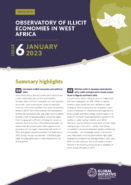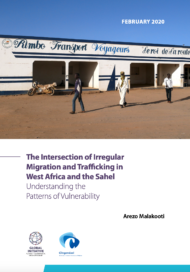Posted on 14 Dec 2020
Following the cessation of hostilities in Libya and the efforts of Interior Minister Fathi Bashagha to decriminalize the country’s security sector, there are grounds for considering whether there is now scope for reform of Libya’s migrant-detention system. But, given the involvement of militia groups in the detention centres and Libya’s post-conflict politics, what are the prospects for reform?
On the night of 2 July 2019, an airstrike hit the Tajoura detention centre outside Tripoli, killing 53 migrants. The outcry for the closure of such centres in Tripoli was immediate. Observers asked why hundreds of migrants were being held at such a site, with the conflict raging around the country’s capital. Governments called for immediate changes to Libya’s policies on holding migrants. Yet, over a year later, little has changed. Detention centres continue to operate adjacent to military sites, and these centres are secured by militias, some of whom fought in the 2019–2020 conflict to control Tripoli.
There are 34 detention centres holding an estimated 3 200 migrants in Libya, 20 of which – at least nominally – fall under the authority of the Department for Combating Illegal Immigration (DCIM). The fact that all detention centres in the country are secured by militias is problematic, not only because this enables abuse against detainees but also because the militias are active in armed conflict. In the Tariq al-Sikka centre, for example, many of the guards fought on the side of the UN-recognized Government of National Accord against the Libyan Arab Armed Forces (LAAF) during the 2019–2020 conflict. Another militia, the Abu Salim Central Security (ASCS) force, guards the Abu Salim detention centre. That militia was heavily involved in the conflict, taking many casualties in the area around Tripoli International Airport.
Investigation and Deportation Units (IDUs) are another element in Libya’s detention system. Their emergence has coincided with increasing numbers of unauthorized migrant releases at disembarkation points. These migrants can end up in an IDU before being transferred to a detention centre. IDUs are also run by militias, despite their semi-formal status under the DCIM.
How militias benefit from involvement in detention
Militias benefit from detention centres through their involvement in human smuggling or trafficking networks, by using detainees for labour, by diverting goods intended for detainees, or posturing as state security services to boost their legitimacy.
In the Souq al-Khamis area near al-Khoms, where human smuggling has escalated, there are several armed groups, and the Souq al-Khamis detention centre lies within their web of operations. Militias bribe or extort migrants for money. The 2017 UN Panel of Experts report found that the al-Nasr Battalion and its commander, Mohammed Kushlav, were complicit in human-smuggling operations around the Zawiya littoral. The guards at the al-Nasr centre are likely to have profited from extortion or bribery, along with unauthorized releases of migrants for payments, a form of human trafficking.
Some militias exploit detained migrants for labour. The work migrants are forced to do often involves cleaning weapons and loading ammunition, which risks detention centres being regarded as viable military targets – as was the case with the airstrike on the Tajoura centre in 2019.
Militias in several detention centres also profit by diverting and reselling goods meant for use inside the centres. As militias are not subjected to any meaningful state supervision, they are free to act as ‘gatekeepers’, siphoning off goods in return for the security they provide.
Some armed groups meanwhile present themselves as an extension of the state’s law enforcement. The Subul al-Salam militia, for example, has promoted its credentials as an anti-smuggling actor (despite allegations that it is involved in people smuggling). These tactics are often driven by a desire to gain state backing and legitimacy. Such arrangements potentially offer a safer and more lasting form of job security and income, particularly if any national stabilization or security sector reform processes are realized.
The effects of the conflict
In June 2020, the LAAF were pushed back from Tripoli – a victory for the GNA and its aligned armed groups. Winning the battle for Tripoli has thrown the balance of power in Tripolitania into renewed flux as politicians and militia leaders vie with one another and between themselves for the upper hand in the post-conflict context.
Bashagha is faced with a division of authority between the DCIM’s head, Mabrouk Abd al-Hafiz, and the undersecretary for migration, Mohammed al-Shibani, who has close links to Usama al-Juweili, the commander of the Western Military Region. This division is more than administrative and points towards the interdependence of militia leaders and public officials in the distribution of power.
In July 2020, for example, al-Hafiz removed Mohammed al-Khoja, the leader of the Tripoli militia running the Tariq al-Sikka detention centre. By September, however, it was clear al-Khoja had ignored this instruction and was still in Tripoli. One source said that al-Khoja’s influence had increased within the DCIM because of his role during the Battle for Tripoli. Removing al-Khoja would have increased Bashagha’s authority over the detention system, an effort that has failed.
In another example following the end of the fighting, one of the leaders of the armed group that runs the Mabani IDU was appointed in July by Libya’s prime minister to a senior position in the government’s intelligence service – despite the fact that his militia is known to extort detainees.
Prospects for security sector reform
These developments hint at the contest at play between politicians vying for militia loyalty, and indicate the powerful influence militias exert over state officials and resources. They point to the fact that power in western Libya is still measured by military strength. Even though the conflict has subsided, armed groups continue to retain the power to shape national politics.
This has two worrying consequences. The first is that government officials are forced to formalize ad hoc power arrangements based on whichever armed group happens to hold martial advantage in a given area. The part-formalization of IDUs, where militia-run holding sites are given a veneer of legitimacy through the presence of DCIM officials, suggests as much. This effectively creates a path for individuals involved in armed organized crime, such as al-Khoja and others, to become part of the official state apparatus, whether military, intelligence or government.
Secondly, the fact that competing militia groups control the detention centres and their surrounding areas helps create resistance to a unified central authority. For example, the Abu Salim area of Tripoli, and its detention centre, is controlled as if it were a quasi mini-state by the ASCS.
This is an immensely challenging context in which to pursue security sector reform. Bashagha, the interior minister, has had limited success in pursuing this and he has faced opposition from politically connected militia elites.
In Bashagha’s favour, there have been protests around the country of late demanding better governance. Moreover, some of Libya’s key international partners maintain a particular interest in strengthening the country’s migration governance. Reforming the detention system is an area where several parties’ interests overlap. Delivering such a programme would heed those calls that followed the Tajoura airstrike, avert criminality and do a service to the thousands of migrants currently at risk of abuse. The question remains whether the GNA, faced with these internal divisions, can forge such a path.
Photo credit: UN Photo/OCHA/David Ohana



